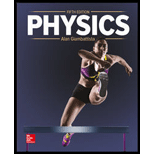
Concept explainers
(a)
The electric potential at the midpoint of two point charges.
(a)
Answer to Problem 31P
The electric potential at the midpoint of two point charges is
Explanation of Solution
The charges are

Write the expression for potential at point due to two charges
Here,
Write the expression for midpoint
Here,
Substitute
The two charges are located on either side of the midpoint. Thus the distances
Substitute
Thus, the electric potential at the midpoint is
(b)
The electric potential at a point
(b)
Answer to Problem 31P
The electric potential at a distance
Explanation of Solution
The first charge is at a distance
Substitute
Thus, the electric potential at a distance
(c)
The work done by an external force in moving a charge at a distance
to the midpoint of the two charges.
(c)
Answer to Problem 31P
The work done is
Explanation of Solution
The charge being moved is
Write the expression for work done by an external agent in moving a charge
Here,
Write the expression for
Here,
Equate (IV) and (III)
Substitute
Thus, the work done is
Want to see more full solutions like this?
Chapter 17 Solutions
Physics
 College PhysicsPhysicsISBN:9781305952300Author:Raymond A. Serway, Chris VuillePublisher:Cengage Learning
College PhysicsPhysicsISBN:9781305952300Author:Raymond A. Serway, Chris VuillePublisher:Cengage Learning University Physics (14th Edition)PhysicsISBN:9780133969290Author:Hugh D. Young, Roger A. FreedmanPublisher:PEARSON
University Physics (14th Edition)PhysicsISBN:9780133969290Author:Hugh D. Young, Roger A. FreedmanPublisher:PEARSON Introduction To Quantum MechanicsPhysicsISBN:9781107189638Author:Griffiths, David J., Schroeter, Darrell F.Publisher:Cambridge University Press
Introduction To Quantum MechanicsPhysicsISBN:9781107189638Author:Griffiths, David J., Schroeter, Darrell F.Publisher:Cambridge University Press Physics for Scientists and EngineersPhysicsISBN:9781337553278Author:Raymond A. Serway, John W. JewettPublisher:Cengage Learning
Physics for Scientists and EngineersPhysicsISBN:9781337553278Author:Raymond A. Serway, John W. JewettPublisher:Cengage Learning Lecture- Tutorials for Introductory AstronomyPhysicsISBN:9780321820464Author:Edward E. Prather, Tim P. Slater, Jeff P. Adams, Gina BrissendenPublisher:Addison-Wesley
Lecture- Tutorials for Introductory AstronomyPhysicsISBN:9780321820464Author:Edward E. Prather, Tim P. Slater, Jeff P. Adams, Gina BrissendenPublisher:Addison-Wesley College Physics: A Strategic Approach (4th Editio...PhysicsISBN:9780134609034Author:Randall D. Knight (Professor Emeritus), Brian Jones, Stuart FieldPublisher:PEARSON
College Physics: A Strategic Approach (4th Editio...PhysicsISBN:9780134609034Author:Randall D. Knight (Professor Emeritus), Brian Jones, Stuart FieldPublisher:PEARSON





